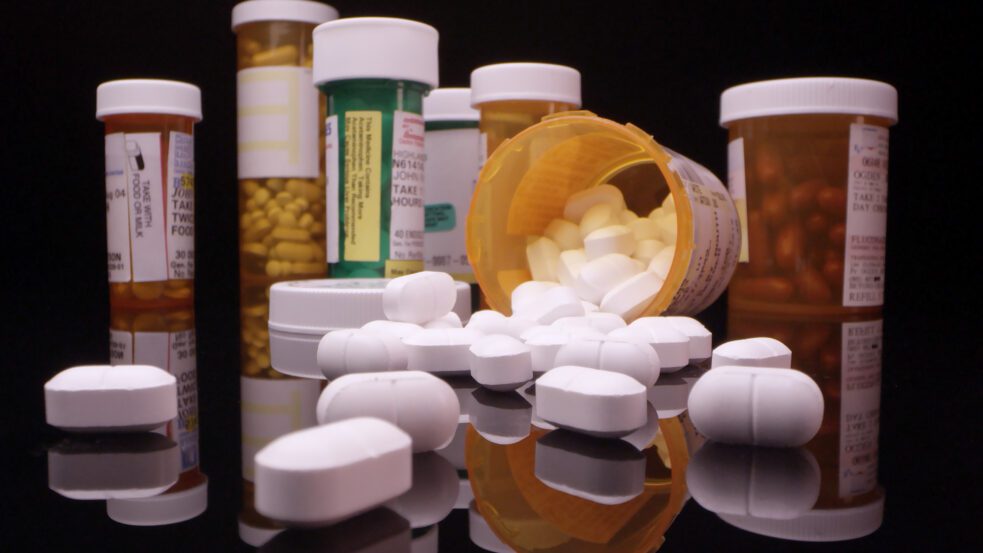Pain was one of the first sensations Brandy, 44, remembers.
Born with spina bifida occulta, a defect that kept part of her spine from fully forming, she spent her childhood learning how to endure it.
When she was about 19 or 20 years old, in the early 2000s, the pain became worse, and her doctor prescribed her a low dose of hydrocodone, an opioid pain reliever.
“I was amazed because it worked,” she says. The medication lowered her pain enough that she could get through college courses and basketball practice.
For the past two decades, Brandy has cycled on and off the medication as her condition has progressively deteriorated, necessitating several surgical interventions, including the removal of once-stabilizing rods that had begun to bend and protrude from her back, a Cesarean section, and a spinal fusion.
But in 2010, when Brandy decided to fill her hydrocodone prescription at a pharmacy nearer to her home, she noticed it came from a different manufacturer. Thinking nothing of it, she took her medication as prescribed — but her pain worsened.
As the days went on, Brandy struggled to get through her shifts as a cocktail server and stopped accepting extra shifts she would have usually taken. When she would get home, she’d have to tell her two-year-old daughter, “Honey, I’m just so tired, I need to sleep. My legs are hurting me.”
After a few months, Brandy decided to ask her doctor about the change. He suggested she might be reacting to the drug’s inactive ingredients — like fillers and binders — which can vary between manufacturers. He advised her to return to her old pharmacy, hoping they still sourced from her previous manufacturer. So, despite a longer drive, that’s what she did, and the medication seemed to work again.
That was about 15 years ago.
The experience stayed with her. Now an advocate for pain patients in Michigan, Brandy says she’s heard from many others who, like her, feel their medications aren’t working as they once did. While she offers tips for talking about the issue with doctors, Brandy says many patients avoid the conversation for fear that doctors will interpret their complaints about a lack of efficacy as a sign of addiction, and stop prescribing them medication entirely.
One physician told MedShadow he considers a patient’s request for a specific manufacturer a “red flag,” for psychological dependency, but added that he uses the conversation as an opportunity to try and help the patient become more comfortable with drugs from different manufacturers, rather than stopping treatment.
The manufacturer can make a bigger difference than most people realize. MedShadow has been investigating what happens when patients receive the same medication from different manufacturers. On paper, the drugs should be identical, but people who rely on certain drugs tell a different story.
Opioid Efficacy Issues: How Big Is the Problem?
Because we found no studies comparing the quality of opioids across manufacturers, we turned to FDA data — analyzing drug recalls and inspection reports from companies that make or distribute these medications — to understand how widespread the problem might be. While backlogs in FDA inspections and limited third-party testing mean some quality issues may go unreported, the available data suggest that certain opioids may be more prone to problems than others, and that several are produced in facilities with years of quality control violations documented in their inspection reports.
“We in medicine, and in the public, are conditioned to accept that generic formulations of drugs, or any other formulation of the same specific medicine, are usually equivalent. But there is good evidence that isn’t always the case,” says Ryan Marino, M.D., an assistant professor of psychiatry specializing in addiction medicine and medical toxicology at Case Western Reserve University School of Medicine.
We in medicine, and in the public, are conditioned to accept that generic formulations of drugs, or any other formulation of the same specific medicine, are usually equivalent. But there is good evidence that isn’t always the case.
Inside the FDA’s Limited Oversight of Drug Quality
The FDA samples and chemically analyzes a small number of generic and brand-name drugs on the U.S. market that it suspects of having a safety, effectiveness, or quality issue each year, and opioids have been included in the FDA’s annual surveillance testing since 2015.
In total, the agency has sampled 183 opioid products over the last 10 years — only a fraction of the hundreds of opioid variations available.
Of the products examined, almost all were tested for the presence and quantity of the active ingredient through an assay or identity test (to make sure the drugs were not counterfeit); 135 were tested for impurities or adulterants; and only three were evaluated for the drug’s dissolution rate, a measure of how much of the active ingredient is released into the body over time.
In the last decade, every opioid tested for quality has passed FDA review. The sole exception since 2015 was a buprenorphine patch that failed because it tore apart too easily.
While these tests assuage concerns about counterfeit opioids flooding the market, the FDA focuses most of its regulatory efforts on conducting regular inspections of laboratories that make the medications — surveillance that the agency has struggled to maintain. The agency notes that testing small samples from select batches isn’t enough to guarantee quality. Regular inspections, it explains, are meant to prevent substandard medications from being produced in the first place.
During these visits, inspectors review the cleanliness of the lab and its equipment, the training of the employees, manufacturing protocols, quality control strategies, and documentation habits to ensure that the laboratory is making medicines in compliance with Current Good Manufacturing Practices (CGMP).
During this process, inspectors do not typically take samples of drugs to be chemically analyzed unless they are already aware of a problem, according to Patrick Stone, a former FDA inspector and President of TradeStone QA.
However, even if problems do arise during an inspection, a 14-month investigation from ProPublica has found that certain labs continue manufacturing drugs for U.S. consumers because blocking all of the medications made by specific labs would cause major drug shortages.
Incorrect Doses and Contamination: The Scope of Recent Opioid Recalls
If a drug manufacturer learns through an FDA inspection (or patient reports, or employee observations in the lab) that one of its medications is defective or could potentially harm patients, it can issue a recall. The FDA can also request that a company recall its products, but it cannot force the company to do so.
Once a company issues a recall, it notifies the FDA, which categorizes the recall as Class I, Class II, or Class III based on how serious the risk is to patients. If the recall is Class I, the most severe, a company may reach out to consumers directly and advise them to stop using the drug immediately; if it’s Class III, the company might only inform wholesalers who will stop distributing the product to pharmacies, but allow consumers to continue taking any medication they already have.
Between 2015 and 2024, the U.S. averaged 323 drug recall events per year. On average, 5.42% of those recall events included one of the following nine opioid medications: fentanyl, hydrocodone, hydromorphone, methadone, morphine, oxycodone, buprenorphine, meperidine, or tramadol.
MedShadow analyzed recalls for those nine opioid medications from 2002 through September 2025. In the graphs below, recall events involving multiple doses of the same medication are counted once, while events involving different opioid medications are counted separately.
Deviations in Current Good Manufacturing Practices (CGMP), likely surfaced during FDA inspections, were the most common reason for recalls. That doesn’t necessarily mean a drug would be ineffective or harmful, but it does mean the company couldn’t guarantee it was properly manufactured. However, the analysis showed that problems with incorrect doses and contamination also occurred.
When contacted for comment regarding MedShadow’s analysis, doctors had varied responses.
Dr. Marino called the findings “quite concerning,” noting that many of the recalls occurred during years when multiple opioids were already in short supply.
Conversely, Mike Martinez DO, chronic pain director at the Anesthesiology Residency Program of Baylor Scott & White Texas Christian University Barnett School of Medicine, suggested that the overall frequency of recalls compared to the number of approved drugs on the market remained limited, which he says “supports the view that the FDA functions properly to ensure drug safety for patients.”
The most frequent recalls involved fentanyl products.
“The fentanyl patches that are frequently used for acute pain, and unfortunately, frequently used for chronic pain — I was doing the math, over 50 million patches were returned,” notes Julio Nunes, M.D., a fourth-year Psychiatry Resident at Yale University and Chief Resident of Outpatient and Addiction Services at the West Haven Veterans Affairs (VA), of the data. “[They weren’t recalled] because the label said something wrong, but because there were leaked seals with potential for underdosing, or even worse, over-delivery of the medication with high risk of overdoses. That, for me, was the most shocking finding,” he continues.
The fentanyl patches that are frequently used for acute pain, and unfortunately, frequently used for chronic pain — I was doing the math, over 50 million patches were returned.
Sylvie Stacy, M.D., chief medical officer at Rehab.com, prescribes methadone and buprenorphine to treat patients with substance use disorders. While she rarely sees problems with these generic medications, she tells MedShadow that the recall data shows that “recalls related to dose or manufacturing problems do happen,” adding that, “this can be a serious issue for patients taking opioids, especially if there is incorrect labeling or potency issues involved. With opioid medications, even small deviations could affect someone’s response to the drug and the overall safety of it.”
A Change in Manufacturer Left Him ‘Psychologically Tortured’
From 2012 to 2024, Greg, 34, was prescribed buprenorphine, a medication often used to manage chronic pain or treat substance use disorders. The drug comes in several different forms, but he found that a tablet that dissolves under the tongue worked best for him.
The brand-name version of this medication, Subutex, was discontinued in the U.S. in 2011, but manufacturers still sell generic forms. Most months, Greg received buprenorphine made by West-Ward Pharmaceuticals (now known as Hikma), but every now and then, he’d get a refill from another manufacturer.
For Greg, the difference was obvious.
Tell Us Your Story
If you take generic opioids for chronic pain, have you seen differences in effectiveness or side effects when the manufacturer changes?
Share your experience: Jessica@MedShadow.org
Instead of lasting all day, the effects of the dose seemed to wear off early, and withdrawal symptoms began a few hours before his next scheduled dose.
“It was hell,” Greg says. It’s “the worst flu you’ve had in your life times 10,” plus feeling “psychologically tortured.”
In February 2025, Greg switched to methadone, another medication for substance use disorders. So far, he says, the medicine he gets from his New Jersey-based clinic has been consistent and hasn’t caused him any issues.
From Pennsylvania to India: What Inspections Reveal About the Global Opioid Supply
In an effort to trace manufacturing problems that may have led to opioid recalls, MedShadow turned to the FDA’s inspection reports on drug manufacturing labs. To highlight the drugs most likely to affect people’s daily lives, MedShadow narrowed its analysis to the past decade, focusing on opioids most commonly prescribed for at-home use — where quality problems can go unnoticed longer by both patients and healthcare providers. These include medicines in tablet, oral solution, or patch form. We excluded medications delivered intravenously (IV) or via injection, as those are typically administered by a healthcare provider in a medical setting.
In the last 10 years, eight companies initiated more than one recall for opioid medications. We used Inspections, one of the FDA’s Compliance Dashboards which compiles reports from FDA inspections, to examine each company’s inspection history.
The graphic below shows a timeline for each company, with each point representing either an inspection of the facility, or a recall of an opioid product.
The FDA classifies inspections as having either No Action Indicated (NAI), meaning there were no concerning problems found during the inspection; Voluntary Action Indicated (VAI), meaning that the inspector did identify either problematic practices or conditions (such as poor recordkeeping or dirty equipment) but that the findings were not severe enough that agency is prepared to take regulatory actions against the company; and lastly, Official Action Indicated (OAI), which means the inspection identified poor conditions or practices egregious enough that FDA recommends making changes to avoid regulatory actions such as import alerts, which prevent drugs made from certain manufacturers with a history of quality issues from being sold in the U.S..
A clear example of an inspection that exposed poor manufacturing practices and led to a recall came in 2019.
In April, an FDA inspector learned that employees at Pennsylvania-based KVK Tech, Inc., had noticed particles in a liquid medication that weren’t supposed to be there. Instead of investigating the source of the particles or whether the contamination affected the medicine, the company simply filtered them out and released the drug to market. Under FDA pressure, KVK Tech issued a recall that November.
That month, the company also recalled its Hydrocodone Bitartrate and Homatropine Methylbromide Oral Solution, an opioid cough suppressant, for particle contamination.
Experts estimate that only 14% of the active ingredients in our medications are made in the U.S., and more than half of all manufacturing facilities are overseas. Companies that manufacture or distribute opioids, however, must apply annually to the Drug Enforcement Administration (DEA) and can only make or import a set amount of opioids, designated by the agency. While the DEA doesn’t explicitly specify a preference for domestic manufacturers, the result may be that few overseas laboratories manufacture opioids.
In fact, while tracking drugs through the manufacturing pipeline from 2011-2020, Randy Hatton, PharmD, a clinical professor of Pharmaceutical Outcomes and Policy at the University of Florida, says he and his team found that the finished drug product for every single controlled substance — including opioids — appeared to be manufactured in the U.S. at the time.
Despite this domestic manufacturing focus, a single medication, controlled substance or otherwise, may pass through several hands before reaching patients: one company might produce the active ingredient, another might press it into tablets, and a third might handle packaging and distribution. Based on FDA inspection reports and recall data alone, it’s nearly impossible to trace where in that chain a problem originated or where a quality lapse occurred.
This can make some manufacturing issues difficult to trace.
On October 18, 2022, Sun Pharmaceutical Industries in Princeton, New Jersey, issued a recall of its buprenorphine and naloxone sublingual tablets, a combination opioid medication. The recall listing states that the drug was manufactured by Sun Pharma’s lab in Dadra, India, a potentially rare deviation from the tradition of manufacturing most of these drugs domestically. While the NJ facility has passed all four of its inspections with no actions indicated since 2018, that’s not the case for the facility in Dadra. There, inspection records show a series of failures.
In December 2023, an inspector found a printout in the scrapyard showing that an item had been weighed at 8.007g. When asked why the record had been thrown out, the product technician told the inspector that it was normal for employees to toss out records of printing and weighing errors.
At that same visit, the inspector noticed stagnant water inside of an air purification unit and tests showed the water contained microbial, yeast and mold colonies “too numerous to count,” which the purifier could spread throughout the lab.
Between January 2019 and December 2023, the facility received 166 complaints of ineffective drugs in the U.S. Because a contract company collecting complaints failed to verify batch numbers, Sun determined that 111 (67%) of those complaints were unsubstantiated and therefore did not investigate them. The inspection report blocks out the names of the drugs.
A warning letter issued on June 18, 2024, states that similar problems have been observed by inspectors throughout Sun’s large network of labs that supply the U.S. market with hundreds of medications including medicines for ADHD, depression, addiction, pain, epilepsy, hypertension, Parkinson’s and more.
What You Can Do
MedShadow’s investigation demonstrates that quality issues with opioids can and do happen, but the scope of the problem remains unquantified. Here’s what to do to protect yourself:
- Talk to your doctor or pharmacist and maybe even find a new one.
If you notice your medication isn’t working or you have new symptoms that you suspect are side effects, Dr. Marino says the first step is to talk to your pharmacist and your prescriber. If those conversations aren’t helpful, he adds, “then I would honestly recommend finding a new pharmacy or a new prescriber.”
- Report your experience to MedWatch, the FDA’s adverse event reporting database.
Be sure to include as much information as you can, including the medication’s manufacturer and lot number. These details help the agency notice patterns and identify medications that warrant further investigation.
- Contact your local representatives to advocate for more transparent labeling, third-party drug testing and more frequent and effective laboratory inspections.
Brandy advises patients to stay calm when raising these concerns with their healthcare providers and to come prepared with printouts of articles or examples of quality issues involving other medications, such as ADHD stimulants, to show that these problems are real. From there, she recommends having an open conversation about possible next steps, whether that means trying a different pharmacy or discussing switching to the brand-name drug.






